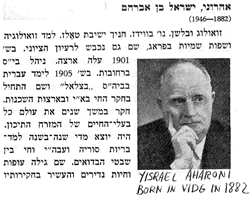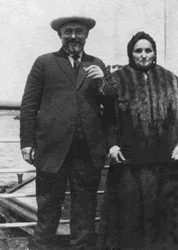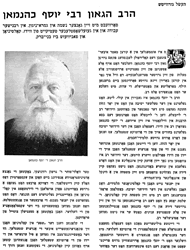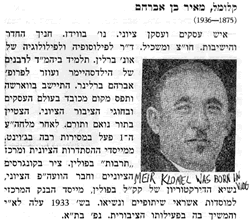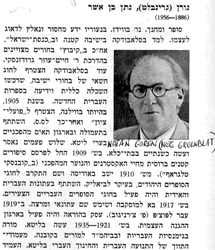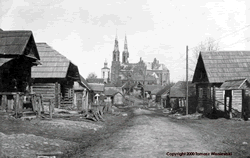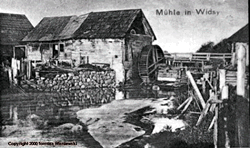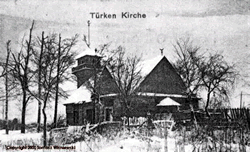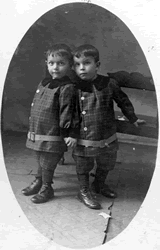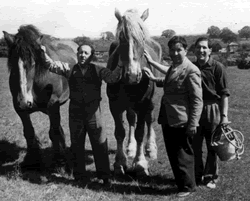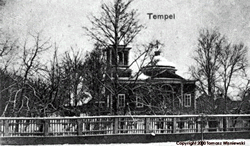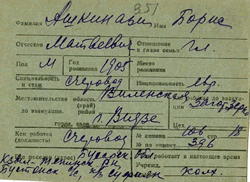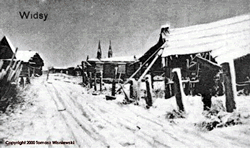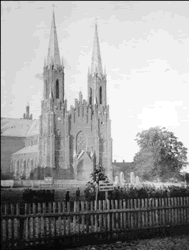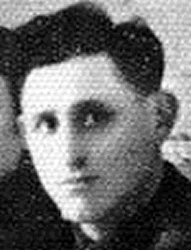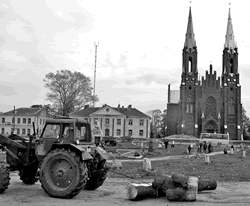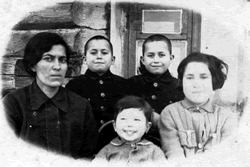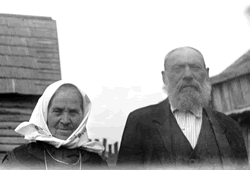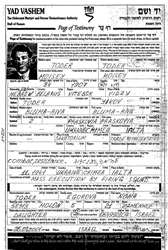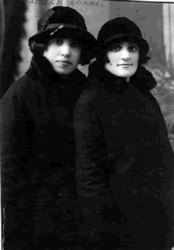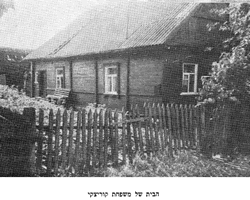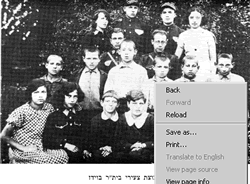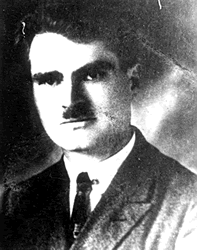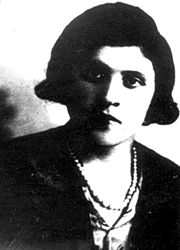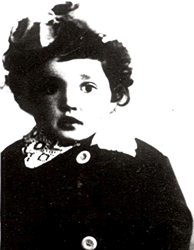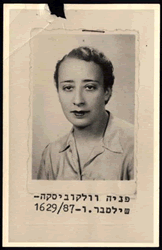Latitude: 55º24' Longitude: 26º38'
Vidzy is located 26 kilometers from the train station at Dukst, on the
Vilna-Dvinsk line, 125 kilometers north of Vilna. 110 miles north west of Minsk.
Prior to World War I, it was part of the Russian Empire; It became part of Poland in 1920. 1939 the Soviet entered , then they gave it to Lithuania, in 1941 Nazi Germany took over, it was incorporated into Belarus (under the Soiviets) in 1945. Today it is in the North west part of belarus near the Lithuania and Latvian border.
Latitude: 55º24' Longitude: 26º38'
Vidze, Widze, Vidzy Belarus 110.1 miles North West of Minsk
|
#vidz-1: Yisrael Aharoni (Aharonovitz) (born in Vidgy in 1882- died in Israel in 1946), from 1901 in Eretz-Yisrael, pioneer of research of fauna of Eretz-Yisrael and neighbouring countries, established the Zoological Museum at the Hebrew University in Jerusalem, lecturer on Zoology at the University.
|
#vidz-2: my grandfather; Yosel Lipkovitz with family. Widze early 1930' .
My father (in a dark suite) is standing in the center. Zeev Lipkovitz, Rehovot. |
#vidz-3: Moshe Eliezer Kramer and wife; Rachel Elka ( sister of Baruch Hodesh of Vidgy) |
|
#vidz-4:
|
#vidz-5: HaRav Yosef Shlomo Kahaneman, the Ponevezher Rav, was also the Rabbi of Vidg. In 1911 soon after he married the daughter of the former Rabbi of Vidg he replaced him when his father in law got a rabbinical position in Vilkomir. To read about him click
HERE |
#vidz-6: KLUMEL Meir was born in 1875 in the shtetl Vidzy, Kovno he died in 1936. He was Public Figure 3127. He was a member of the Public Committee for the Celebration of the 20th Anniversary of the Haynt Klumel, Meir: Mischpatim, ein samaritanisch-arabischer Commentar zu Exodus 21-22,15, von Ibrahim ibn Jakub. Nach einer Berliner |
|
#vidz-7: GOREN Natan (nee Greenblat) was born in 1887in the shtetl Vidzy.He moved to Kovno Wrote for the Jewish paper. He died in 1956 in Tel-Aviv. Author and Hebrew essayist and literary critic, who held the position of chairman of the Israel writers' organization.
|
#vidz-8: Szlomo Jechilczyk born in Vidgy in 1924. A partisan during the war.
|
#vidz-9: A Street |
|
#vidz-10: The Mill |
#vidz-11: The Tartar Mosque |
#vidz-12:
|
|
#vidz-13: My father Isaac Swirsky (anglicized to Oscar) was George's twin. Photo taken either in Vidz or in Kirsanov (Russia) before they left for England in 1913, when they were 2.5 years old. |
#vidz-14:
|
#vidz-15: This is a photo of my grandfather, Abraham Swirsky,(born in Vidz) on his farm in England in about 1940. He is standing between the horses, and one son, George (Gershon), is closer to him, the other, Max is holding the bucket.. ( submitted byYehoshua Sivan |
|
#vidz-16: The Orthodox Church |
#vidz-17: Card of Boris Ashkinazi Matveyevich of Vidze, a Jewish Refugees in |
#vidz-18: My grandfather, Abraham Swirsky with my grandmother, Yudis (Yehudit), a the daughter of Ber Sholem Dov Okun and Haya Sragowitz . ( submitted by Yehoshua Sivan) |
| #vidz-19: |
#vidz-20: |
#vidz-21: |
#vidz-22: Faivel (son of Henoch and Dveire nee Shalemak) RUTSHTEIN 1903-1941(42) Born in Vidzy Perished in the Holocaust |
#vidz-23: The park of Vidzy. For more pictures go to; |
#vidz-24: The family of David (son of Yosel Todres) and Mina ( daughter of the Olsfein family) Horacio Todres hht.1212@y |
#vidz-25: My maternal great-grandparents, Leon Shmuel FLEXER and Frejda (nee GANTOVNIK) taken 24 September 1928 in Vidzy. |
#vidz-26: |
#vidz-27: Moisei Toder was born in Vidzy in 1907 to Yakov and Blyuma. He was a merchant and married to Praskovya. Prior to WWII he lived in Yalta, Russia (USSR). During the war he was in the resistance in Russia . Moisei was murdered in November of 1941 in Yalta, Russia (USSR) at the age of 34. |
#vidz-28: |
#vidz-29: The home of the Koritzky family in Vidz |
#vidz-30: Members of the Bitar youth movement before the war |
#vidz-31: Jankel Malacki was born in Widze, Poland in 1889 to Itzchak and Toibe. He was married to Kreina nee Flexer. Prior to WWII he lived in Widze, Poland. During the war he was in Widze, Poland. Jankel was murdered/perished in 1941 in Widze, Poland. This information is based on a Page of Testimony submitted by his daughter in New Zealand. |
#vidz-32: Kreina Malacki nee Flakser was born in Widze, Poland in 1897 to Shmuel and Freide nee Gantovnik. She was a teacher and married to Jankel. Prior to WWII she lived in Widze, Poland. During the war she was in Wilno, Poland. Kreina was murdered/perished in the Shoah. This information is based on a Page of Testimony submitted by her daughter Freda Narev of New Zealand. |
#vidz-33: Esther Malacki was born in Widze, Poland in 1929 to Jankel and Cora nee Flakser. She was a child. Prior to WWII she lived in Widze, Poland. During the war she was in Panevezys, Lithuania. Esther was murdered/perished in the Shoah. This information is based on a Page of Testimony submitted by her sister. |
#vidz-34: Fania nee Kowarsky was born in Vidze To Chaia Sara and Yaakov. She was married to Dr. Noach Leon Wolkowski and lived in Vilna. They and had a son Alic ( later Alexander Tamir). Her husband perished in the holocaust. She and her son survived and immigrated to Israel.
|
#vidz-35: |
#vidz-36: |
http://www.jewishgen.org/yizkor/Vidzy/vid001.html
The Sabel family lived for generations in Vidzy. To read and see pictures go to
http://www.sabelfamily.org/family.htm
Please share your comments or photos or links for posting on our Guestbook Page here: egl.comments@gmail.com
Kaddish for our shtetl
by Gershon Winer
More than half a century has elapsed since the destruction of our
shtetl Widze. Year after year, in the beginning of the month of Nisan,
the Widze remnant in Israel gathers in Tel Aviv for the annual
memorial, bringing to mind nostalgic recollections of home and family
intermingled with remembrance of years of suffering and death. About
1100 cities and towns in Eastern Europe have their history, life,
institutions and personalities recorded in memorial volumes along with
personal testimonies on the tragic destiny of victims and survivors in
the ghettos and camps and the heroic deeds of Jewish underground
fighters. Widze is not among them. Our Jewish shtetl was erased from
the face of the earth with no monument nor written record for future
generations, for children, grandchildren, students and researchers.
The publication of the present volume finally amends for the omission.
It took some years of planning, communicating with townspeople and
their descendants dispersed throughout the world, assembling data,
securing written memoirs, commissioning specific articles, searching
libraries, editing material and assuring the necessary funding. Our
obligation to past generations and our responsibility to the future
have thus been fulfilled, at least as far as the printed word is
concerned.
Let us begin with geography and continue with history.
A report issued in 1930 states: Widze is 26 kilometers by road to the
train station at Dukst, on the Vilna-Dvinsk line, 125 kilometers
northeast of Vilna. It is located in a beautiful area, surrounded by
lakes, forests and also mineral springs which during the nineteenth
century served as healing centers for near and far. Russians,
Lithuanians, Poles, Tartars, and of course Jews, make up the local
population. There's a Catholic church, a Greek Orthodox church, a
Mohammedan mosque, and three synagogues of which the two smaller ones
are of the Hasidim.
Throughout history, Widze, often spelled Vidzy, was regarded as one of
the four largest market places in Lithuania. Established over 500
years ago in the Lithuanian kingdom, its history was marked by
numerous wars: Russians vs. Swedes; Lithuanians vs. Poles; Germans vs.
Russians. Prior to World War I, it belonged to Russia; afterwards, it
became Poland. During World War II, again Russia, then Lithuania,
later Nazi Germany, and finally it was incorporated into Belarus. The
same fate was shared by many towns in the Vilna district. Widze was
destroyed numerous times, in various wars and by fire. It happened
twice in the lifetime of the previous generation. At the beginning of
the First World War, battles in the area forced nearly the entire
Jewish population to flee. About fifty who remained were subjected to
persecution, torture and rape, while most of the town was left in
ruins. After the war, less than half of the previous population of
about 4,000 Jews gradually returned to rebuild their lives and the
Jewish community. The last destruction began with the invasion of the
Germans in June 1941, which culminated with the final chapter of the
Widze ghetto, as the remaining survivors were transported to their
death in the Ponar woods near Vilna on April 5, 1943. In the early
1990's there remained one old Jewish woman in town and she would not
identify herself as a Jew.
I left my hometown at the age of eight. When I returned nearly sixty
years later in 1989, the only landmark I could identify was the church
with its two steeples that struck us with awe when we were children.
There were Jews in Widze already in the fifteenth century. The 1894
census lists the following breakdown: Catholics 661, Russian Orthodox
407, Greek Orthodox 320, Tartars 200, Karaites 5, Jews 4348. A 1931
report by a Jewish relief agency mentions a population of 450
families, among them 230 Jewish, in round numbers. This would mean
some 1200 to 1500 souls. The sharp Jewish decline reflects the flight
during the war years.
Widze earned "honorable mention" in our people's history on account of
the conflict between Hasidim and Mitnagdim. The World History of the
Jewish People by Shimon Dubnow records that in 1798, in the midst of a
violent controversy dividing the Jewish community, as rabbis fought to
suppress the newly emerging Hasidic movement, a Hasidic shochet of
Widze was responsible for informing on irregularities in the Vilna
Kehilla, which led the Russian authorities to arrest its leaders.
Though the founder of Habad, the school of Hasidism which took root
among Lithuanian Jews, Rabbi Shneur of Ladi, issued a call against
further strife, mentioning the Widze incident by name, relations
between the factions became even more strained following the release
of the Vilna leadership. In a remarkable coincidence 130 years later,
another controversy between Hasidim and Mitnagdim broke out in Widze,
though not in such brutal form, involving once again the local
shochet. I recall the episode when "Reb Mendl the shochet" (Klumel)
was crowned by the Hasidim as their Rebbe, and prominent rabbinic
personages were brought in to resolve the issues.
Widze contributed its share to the galaxy of personalities who played
a leading role in Jewish life in the last century. Rabbi Joseph
Kahaneman, founder of the Ponevez yeshiva in Bene Brak, the largest
yeshiva in Israel, had served as rabbi of Widze for five years before
the First World War. He established a yeshiva for 150 students which
was destroyed in 1915. Israel Aharoni, who pioneered in zoological and
botanical studies in Israel, was born in Widze and came to Palestine
in the early part of the century. In his numerous research expeditions
throughout the area, he assembled a fauna collection still preserved
in a church museum in the Old City of Jerusalem. His autobiography
written in Hebrew, Memories of a Hebrew Zoologist, made fascinating
reading for me as a youngster. Our town also made its contribution to
literature in the person of Natan Goren (Greenblatt), Hebrew essayist
and literary critic, who held the position of chairman of the Israel
writers' organization. Then there was the Yiddish poet, Baruch Gelman,
whose volume of poems published in 1937 depicts local scenes and
expresses the prevailing and often gloomy mood in the town, while
striking a nostalgic tone. It was reissued in 1990 by the Widze
Association in Israel. The young poet met his death together with his
five brothers and sisters in the Widze pogrom of 1941. There was also
Dr. Meyer Klumel (of the previously mentioned Klumel family) who
played a leading role in the Zionist movement in Warsaw before leaving
for Palestine in the 1930's, where he died in 1936.
Jewish community life presented numerous opportunities for religious,
educational, political, artistic and recreational activity. Besides
the three synagogues listed, functioning in the traditional pattern
for worship and study, there was the Yiddish school building serving
as the cultural center. Established in 1921 largely through the
generosity of the Zlatkin family, it offered a six-year curriculum of
Jewish and general studies. It was a secular school and, in keeping
with the then accepted practice, all disciplines, including science,
were taught in Yiddish. I recall to this very day a lesson in physics,
conducting an experiment on how metal expands when heated. Most
children of elementary school age were enrolled in the school. The
teachers were dedicated intellectuals sent in from the central office
of the Yiddish school organization in Vilna. These would become
actively involved in the cultural life of the community. The memoirs
appearing in this volume include nostalgic recollections of the
teachers and the warm atmosphere generated in the school which was
carried over to a wide range of extra-curricular activities, both in
the school building and in the countryside with its woods and lakes.
Students remember with fondest sentiments teachers such as Sioma
Halpern and his wife Dina. The building also provided facilities for a
choir, a dramatic group and had an auditorium for lectures and
artistic performances.
Then there was the "Heder" of "Yankel der Lerer", as he was known, the
only one in town during my childhood years. The very appellation of
"lerer" instead of "rebbe" is revealing as to the content of
instruction and the religious and cultural climate of our shtetl. The
traditional Heder curriculum throughout the centuries had been aimed
largely at introducing the pupil at the tender age of seven or eight
to the rigor of Talmud study, with its emphasis on legal
technicalities and minutiae at the expense of everything else, with
the exception of the weekly Torah portion. In contrast, our Heder
opened up for us -- among other subjects -- the world of the Bible
with its exciting tales of ancient Israel and the inspirational
rhetoric of the Prophets. I still cherish fond memories of the book of
Isaiah, recited with a chant along with the Yiddish translation by the
"older" students of age 10, and how I envied them. The fact that many
children attended both the religious Heder and the secular "Shule", is
a further indication of the prevailing unifying spirit, as borne out
by the composition of the board of the school which included leaders
of the religious community as well.
The marked division and even gulf separating the religious from the
secular in Israel today, and to a somewhat lesser though significant
degree elsewhere among world Jewry, did not exist in the Lithuanian
shtetl before its destruction. This is not in keeping with the
stereotype shtetl in the mind of the contemporary Jew. The fanatic
zeal of the ultra-orthodox manifested in temperament, garb and
practice which we witness today, was alien to the Litvak mentality. It
is largely a modern phenomenon, though we find its roots among our
Polish and particularly Galician and Hungarian brethren of previous
generations. Beside the Yiddish school-cultural center which played
such an important role, Widze could not boast of a Tarbut school, with
its modern Zionist-Hebraist education, as some towns in the area.
However, its only continuously functioning Heder was quite different
from what the name generally conjures up in our minds, the curriculum
reflecting the changes introduced by the modernizing tendencies of the
Haskala (enlightenment) movement of the preceding century. Neither was
there a Yeshiva, though as mentioned, one did exist for a few years
before the first war. Nor should this be regarded as any negative
reflection on the religious life of the community, its rabbis,
synagogues and institutions. In this respect, it represented the norm
rather than the exception in Lithuanian Jewry which nevertheless
produced the leading Orthodox sages and Talmudic scholars in the
twentieth century. And to this very day, the "Litvishe" yeshivas in
Israel and abroad, with their ultra-Orthodoxy, are recognized as the
most prestigious.
In addition to the cultural panorama, with its library, choral group,
drama circle, guest artists and lecturers, the young people were
politically alert and involved. There were Zionist youth movements,
mainly Hechalutz, aiming to prepare for kibbutz life in Palestine.
Communism attracted a high proportion of adherents -- some fulfilling
their dream of crossing the border to help build the new socialist
society, where they soon shared the tragic fate of other
revolutionaries. Political and economic conditions being as they were,
with their entry restrictions in Soviet Russia and Zionist Eretz
Yisroel, the flow of emigration was directed to countries across the
ocean. Many may have reached North America, but the majority of those
who left Widze landed in South Africa and Argentina. The Israel
contingent of Widze descendants consists largely of survivors.
A word about the economic picture which was no different from other
communities: Jews were largely storekeepers and merchants. There were
craftsmen -- shoemakers, tailors, blacksmiths, carpenters and
coachmen, the latter being so indispensable because of the many hours
of travel required to reach the railroad town. A 1930 survey refers to
120 storekeepers, 60 merchants, mostly of flax and 40 craftsmen. The
economic policies of the government in their preferential treatment of
the Polish working population placed ever increasing obstacles for
Jews to eke out a living and compelled them to emigrate to other
lands. Those who were forced to do so, were spared the fate of the
Holocaust. Among them was my own father. Ironically, the anti-
Semitism of the Polish government turned out to be a blessing in
disguise.
The major thrust of this Memorial book is of course the Holocaust,
just prior, during and immediately after. The prior begins with the
Hitler-Stalin pact of 1939, dividing Poland between them. Widze
therefore "belonged" to the Russian partner and the Soviet army
entered the town on September 17, 1939. For nearly two years, while
the Second World War was being waged on the Western Front, the town
was under Communist rule. This meant elimination of private property,
and subjection of all forms of community activity to the Soviet system
including educational and cultural institutions. Life became
problematic but tolerable. The particulars are found in the personal
recollections recorded in these pages. On June 22, 1941, Germany
launched a surprise attack on the Soviet Union and Russian troops
withdrew from Widze, with the Germans entering five days later. In the
interim period, local criminal elements began to rob and harass Jews,
until some semblance of "order" was restored by the occupying forces.
For the nearly two years that followed, the tales of unimaginable woe
that transformed that span of time into nightmarish horror in the
ghettos and camps, are unfolded in this volume.
Initially, we had intended to present English summaries of the Yiddish
and Hebrew memoirs of the Holocaust years as they appear in this
volume. However, after exposure to the details of limitless brutality,
the diabolic and endless torture, wanton murder, sadism, humiliation,
starvation, deprivation, crushing labor, victims digging their own
graves before being shot, relegation to vermin-like mass
extermination, blood curdling scenes of bayoneting babes in arms,
hiding in pits and animal dugouts, while the last spark of humanity,
with few rare exceptions, extinguished even among one's own former
Polish and Lithuanian neighbors -- I lacked the stamina to undertake
such an agonizing task, not having been there in person. Then there
are the acts of heroism, maintaining the human image under all
conditions, joining the partisans in their desperate struggle against
the Nazis, reunification of surviving members of families, waiting in
DP camps before setting out, in some instances by illegal routes, to
reach the promised land whose gates had been closed tight by the
British rulers. All this and more is told in various versions, some
appearing repetitious of others, but with individual nuances
justifying their inclusion.
The present volume with its reminiscences, historical data, Holocaust
testimony, also contains information on institutions and colorful
personages, along with brief biographies of prominent personalities
who emerged from the shtetl and left their impact in various fields of
endeavor. Then there is local folklore representing a rich mine of
characteristic anecdotes, idioms and nicknames -- and just about
everybody was identified by a nickname, not necessarily complimentary
-- the latter inspired by some physical, social or other trait and
idiosyncrasy in the bearer's appearance, habits, behavior, occupation,
status or relationships. All this, which added coloration to the local
scene, does not readily lend itself to translation. An attempt has
been made to render a few of the articles in an abbreviated form into
English, while some of the material contained in the others has been
incorporated in this introductory chapter. The contributions of the
authors are published in the language in which they were submitted --
Yiddish, Hebrew and two in English -- with one or two exceptions
translated from Polish. The commemorative pages for individuals and
families appearing in this volume were made possible by the financial
participation of Widze families in Toronto, New York, New Zealand and
Israel.
Let this book be our recitation of the Kaddish -- in the very meaning
of the words of the prayer itself -- the sanctification and
remembrance of our martyred brothers and sisters and forebears, of the
life they led and the death they met. Amen
( 1915, First world war)...The sequence of expulsions did not end with this great one. Looting and violence were part of the expulsions. In Vidzy the Jews assembled in the synagogue for safety. The Cossacks found out about this and attacked the synagogue, and violated the men's wives and daughters before their eyes
Message: Hi all,
I'm looking for details about Yisrael Aharoni born in Vidzy, Belarus
1880 and
died in 1946 in Israel. I fail to have any details about him, date of
birth,
father, mother family, education and so on...
Could some-one help me,
Justin Jansen
The Netherlands
justindba @ cs.com
http://resources.ushmm.org/uzbekrefugees/name_list.php?IRMIS__FAMILYA_TRANSLIT=&IRMIS__IMIYA_TRANSLIT=&IRMIS__OTCHESTVO_TRANSLIT=&IRMIS__GODROJDENUYA=&IRMIS__PLACE=vi
Image Family Given Patronymic Year Sex Oblast Rayon Gorod Family Given
Patronymic Oblast Rayon Gorod
A/3446 Ashkinazi Boris Matveyevich 1905 M Vilenskaia Vidze
áÛËÉÎÁÚÉ
âÏÒÉÓ íÁÔ×ÅÅ×ÉÞ ÷ÉÌÅÎÓËÁÑ ÷ÉÄÚÅ
A/1456 Avstraikh Frida Iankelevich 1922 F BSSR Vidze á×ÓÔÒÁÊÈ
æÒÉÄÁ
ñÎËÅÌÅ×ÉÞ âóóò ÷ÉÄÚÅ
A/1458 Avstraikh Ginda Iankelevna 1920 F BSSR Vidze á×ÓÔÒÁÊÈ
çÉÎÄÁ
ñÎËÅÌÅ×ÎÁ âóóò ÷ÉÄÚÅ
A/1457 Avstraikh Tsiva Mikhailovna 1900 F BSSR Vidze á×ÓÔÒÁÊÈ
ãÉ×Á
íÉÈÁÊÌÏ×ÎÁ âóóò ÷ÉÄÚÅ
TS/954 Tsipman Moisei Mois 1898 M Litovskaia Vidze ãÉÐÍÁÎ
íÏÉÓÅÊ
íÏÉÓ ìÉÔÏ×ÓËÁÑ ÷ÉÄÚÅ
U/21 Ugol Khaim Shevilevich 1916 M Velisskoi Vidze õÇÏÌ èÁÉÍ
ûÅ×ÉÌÅ×ÉÞ ÷ÅÌÉÓÓËÏÊ ÷ÉÄÚÅ
V/4402 Viduchinskii Zundel' Iakovlevich 1911 M Vilenskaia Vidze
÷ÉÄÕÞÉÎÓËÉÊ úÕÎÄÅÌØ ñËÏ×ÌÅ×ÉÞ
÷ÉÌÅÎÓËÁÑ ÷ÉÄÚÅ
Z/3111 Zil'berman Fida Izrailovna 1900 F BSSR Vidzevskii Vidzy
úÉÌØÂÅÒÍÁÎ æÉÄÁ éÚÒÁÉÌÏ×ÎÁ âóóò
÷ÉÄÚÅ×ÓËÉÊ ÷ÉÄÚÙ
Z/3102 Zil'berman Raisa Tsadykovna 1923 F BSSR Vidzevskii Vavzy
úÉÌØÂÅÒÍÁÎ òÁÉÓÁ ãÁÄÙËÏ×ÎÁ âóóò
÷ÉÄÚÅ×ÓËÉÊ ÷Á×ÚÙ
Z/3142 Zil'berman Roda Lazarevna 1873 F BSSR Vidzevskii Vidze
úÉÌØÂÅÒÍÁÎ òÏÄÁ ìÁÚÁÒÅ×ÎÁ âóóò
÷ÉÄÚÅ×ÓËÉÊ ÷ÉÄÚÅ
Z/3039 Zil'berman Sonia Peisokhovna 1912 F Vineiskaia Vidze
úÉÌØÂÅÒÍÁÎ óÏÎÑ ðÅÊÓÏÈÏ×ÎÁ ÷ÉÎÅÊÓËÁÑ
÷ÉÄÚÅ
Postavsky Oblast, Vitebsk district at 5524 2638, 110.1 miles NNW of Minsk. Alternate name: Vidze Cemetery is in the midst of farmland, completely abandoned with no enclosure or sign. Many stones have sunk into the ground. Many lean while others are missing. Used until the Holocaust, the site was probably at least 150 years old. About 200 stones are now visible. One Jew lives in the town. His name is Dovid, owner of three flourmills. [2000] [Source: Swartz fjs@voluntas.org ]
http://www.jewishgen.org/Yizkor/Vidzy/Vidzy.html [October 2000]
(Vidzy, Belarus)
55°24' / 26°38'
Translation of Sefer Vidz: ayarah behayeha uve-khilayonah
Edited by: ed. Gershon Winer, Yizhak Alperovitz
Project Coordinator
Eudice Winer Harris ( daughter of Gershon Winer, the editor of the book)
http://www.jewishgen.org/Yizkor/Vidzy/Vidzy.html
VIZDY, BRASLAVSKY REGION
http://shtetle.co.il/Shtetls/vidzy/vidzy_eng.html
In 1940 I graduated from Lvov medical institute and began working as a doctor in Sventsiany. Today it is a small town on the territory of Lithuania. Why did I come back to Lithuania from Lvov? I was born in Vilno in 1915, and then lived in Sventsiany, which is 80 km from Vilno. There I attended a Jewish school, later a gymnasium, which was later closed due to lack of funding. So I came back to work in my home country.
Germans invaded Sventsiany on the first days of the war. First I was in a concentration camp called Novo- Sventsiany, which was located 12 km away from town and to which Germans brought Jews from Grodno, Sventsiany and small villages. After spending six days there I managed to escape and later turned out in Sventsiany ghetto. Most of the Jewish population was in the concentration camp, while the ghetto consisted of Jews-specialists, who the German army needed. Rahil Rudnitskaya, Izhak Arad’s sister, registered me as her husband (Izhak was an Israeli general, later head of Yad Vashem).
In 1942 German commandant’s office sent me to Vidzy ghetto, which is today a village in Braslav region. The ghetto had typhus epidemics. The place was mainly populated by old people and women and was created for quick liquidation. However Germans dreaded the typhus would spread. Of course, they were scared for their lives and that was the reason why they sent for a doctor. Sventsiany ghetto had four doctors and I was the only one who did not have a family because my parents and four brothers had died in a camp. I got a reference, which stated that I had been sent to Vidzy for typhus liquidation. I went voluntarily. I knew that the sick were executed.
The ghetto was surrounded by a high fence, however it was not guarded and the entrance was free. Life was comparatively decent; it was possible to buy groceries from local people. This lasted till the autumn of 1942.
The head of the Jewish community was Lipa Levin. He was in charge of medicine, which was acquired in the city pharmacy. So, I had enough medicine.
Jewish craftsmen were still involved in their work, the rest of the people were used for physical work, extremely hard and sometimes useless and humiliating.
The ghetto region was populated only by Jews (around 1,500 people); Belarusians and Poles were made to leave. There were only a few people who had typhus, about 10, and we managed to isolate them.
In the November of 1942 the police forces started arriving from Ukraine and Lithuania. We did not know what to expect from them. Supposedly the aim was to liquidate the ghetto. Later people started saying they arrived to fight the local partisans. However, I did not trust that. I made a decision to leave, because the tension was growing and everyone was expecting the worst. Therefore I left on November 22nd to my friend Igor Tyminsky, who lived near Vidzy. We used to attend the same school. I came and said that I would prefer not to stay in the ghetto on such days. He listened to me and said: “Sure, you can stay”. His father invited me for dinner and also invited me to stay at his place. It turned out that not far from their house there was a peat extraction unit, where ghetto Jews had to work, mostly young and middle-aged men. At night they were planning to escape and join partisans. So I said: “I will go with you.”
I did not mention anything to the Tyminskys and told them I was going to bed. Then I left. I put my medical diploma into a bottle and buried it in the ground. I found it after the war.
Nobody knew the way to the partisans. At 2 a.m. someone started shooting at us and our group (there about 15 of us) was scattered. Later we formed groups of 5-6 people and went on. We walked all night long and found a partisan brigade headed by Prudnikov. That was a special unit, which consisted of security officers. They said they did not need a doctor, neither did they need any people and advised us to join “Spartak” unit, headed by Ponomarev. I was the only one who was allowed to stay in the unit. The rest of the men were told to find weapons first. I never saw them again.
There were very few Jews in that unit. But that was easily explainable, because the unit would not accept anyone without weapons. Where could those people, who escaped from ghettos, find weapons? After the war one of the Jews from the unit worked as a deputy minister in Minsk, and later lived in Polotsk.
I was in the unit until November 23rd, 1943.
I worked as a doctor in a partisan hospital, the only one in Rossony region. There was enough work to do and different patients to deal with. I remember a young woman, her last name was Strui. She used to be a deputy before the war. She told me she had had a special errand to run for partisans and had her legs frostbitten when crossing the front line. It was followed by gangrene, so the patient needed amputation. The hospital did not have an amputation saw and I had to amputate both legs with a regular saw. She found me in the 80s and wrote me a letter. She had artificial limbs made and her life was going well. She often thought of me.
After the war Hanoikh Davidovich Ginzburg lived in Grodno, working as a doctor. He was the one who helped re-establish the Jewish community in Grodno at the beginning of the 90s.
The interview was recorded in 1992
The Yizkor for Vidzy, Belarus
55°24' N, 26°38' E
Original Title: Fertsik yor nokhn umkum fun di Vidzer Yidn z'l
English Title: Forty years after the annihilation of the Jews of Widze
Editor: Yaakov Parmunt
Published: Kefar Giladi [1982/83]
Publisher: The Council of the Society of Widze Jews in the Land of
Israel
Pages: 8 leaves Languages: Y
Libraries
Jewish National and University Library, Jerusalem, , Israel, Call No:
0951375
Vidzy, Belarus
55°24' N, 26°38' E
Original Title: Sefer Vidz: 'ayarah behayeha uve-khilayonah
English Title: Widze memorial book*
Editor: Edited by Gershon Winer, Yizhak Alperovitz
Published: Tel Aviv 1998
Publisher: Widze Association in Israel
Pages: 557 Languages: H, Y
Notes: Date on English title page: 1997
Translation: http://www.jewishgen.org/yizkor/Vidzy/Vidzy.html
Libraries
Bar-Ilan University, Ramat-Gan, , Israel, Call No: Has book
New York Public Library, Jewish Division, New York, NY, United States,
Call No: *PXW(Vidzy) 98-695
YIVO Institute for Jewish Research Library, New York, NY, United
States, Call No: /92449
University of Haifa, Haifa, , Israel, Call No: 0829791
University of Texas, Austin, TX, United States, Call No: DS 135 B38 S43
1998
Jewish National and University Library, Jerusalem, , Israel, Call No:
1781660
Allen County Public Library, Fort Wayne, IN, United States, Call No:
947.6502 V669a
